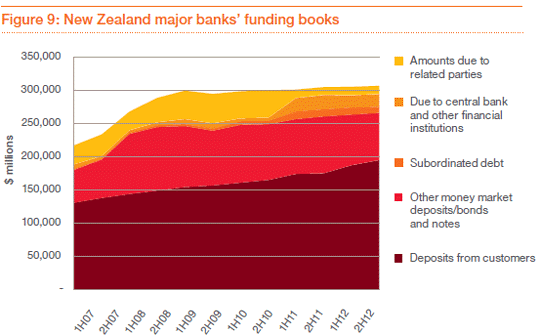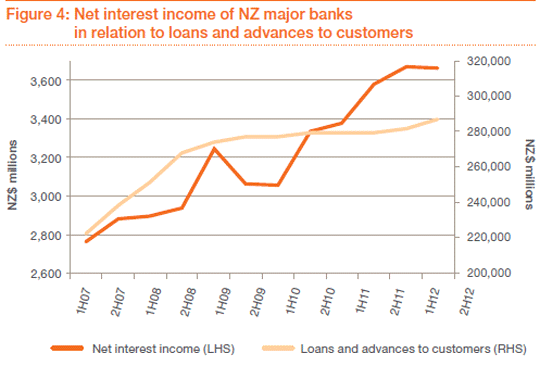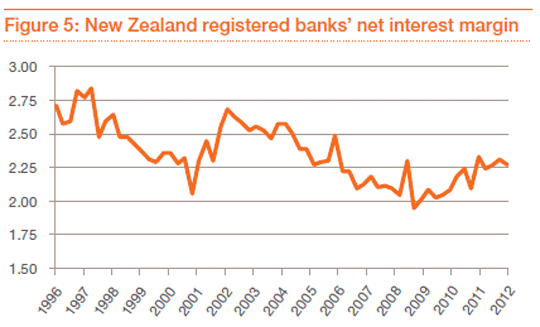
By Gareth Vaughan
New Zealanders have deposited almost NZ$29 billion more in their major banks than they have borrowed from them since 2009.
This nugget is included in PwC's bi-annual Banking Perspectives report covering the second half of ANZ, ASB, BNZ, Kiwibank and Westpac's 2012 financial years. The report also notes that the five banks grew lending in the second-half of 2012 by more than they had in any half-year since the first-half of 2009, although they took in more money in deposits than they lent out for the seventh straight half-year period.
"We're still in an environment where the amount being saved by the New Zealand public exceeds what has been advanced,"' PwC partner Sam Shuttleworth told interest.co.nz. "That gap has narrowed considerably with the net difference a couple of billion dollars."
The percentage of the five big banks' funding obtained from deposits from customers had increased to 64%, or NZ$196 billion, at the end of the second-half of 2012, including a NZ$7.8 billion rise in the half-year, from 52%, or NZ$155 billion in 2009. This has seen the banks reduce their reliance on wholesale funding to 36%, or NZ$112 billion, from 48% of total funding, or NZ$145 billion.

Shuttleworth said he expects to see the deposit intake versus lending growth dynamic move to a more neutral position through 2013.
"With the lending growth that has occurred the banks have released some of their liquid assets which have been sitting in the wings due to a possible dislocation in the (global financial) markets. With a continuation of this growth with the rebuild of Christchurch, with the flourishing property market particularly in Auckland, you can see this becoming more of a neutral position," Shuttleworth said.
The latest Sector Credit data from the Reserve Bank shows housing loans rose 3.7% in the year to December to NZ$177.717 billion, the fastest annual growth rate since January 2009. Agriculture sector debt rose 5.1% to NZ$49.773 billion, its high water mark since the Reserve Bank started compiling the data in 1990, and the fastest annual growth rate since March 2010. Business credit rose 2.5% to NZ$78.8 billion, and consumer debt rose 2.4% to NZ$13.35 billion.
Meanwhile, Shuttleworth also suggested a bullish sharemarket, where last year's 24% rise is expected to continue buoyed by the initial public offering of Mighty River Power and good dividend yields in a low interest rate environment, could prove a drag on deposits this year.
Funding costs down
PwC, an auditing and financial advisory firm, notes good news for the banks on the funding cost ledger. Shuttleworth said funding costs fell during the second-half of 2012 with the big five's interest expense slightly lower in the second-half versus the first-half at NZ$5.743 billion compared with NZ$5.765 billion.
"We don't have any empirical evidence on how much funding costs have come down by. What we do know is the interest expense is relatively flat on a growing funding base, (and) what we can observe from the wholesale markets is the cost to use those wholesale funding channels abroad are showing signs of improvement as the economic conditions in the northern hemisphere improve," said Shuttleworth.
Reserve Bank data also shows bank funding costs trending down.
Shareholders in New Zealand's banks are, meanwhile, doing well compared with shareholders in banks elsewhere in the developed world. Although shareholders' have tipped around NZ$6 billion of equity into the major kiwi banks since 2007 lifting total equity to about NZ$25 billion, their returns on equity have, in PwC's words, been "robust."
"The New Zealand majors return on equity has fallen post GFC (global financial crisis) but only by circa 2% compared with a 5% drop in Australian returns on equity, and a massive 13% drop in global returns on equity from 20% to 7% as a result of the GFC which also caused government bailouts, tightening in prudential regulations and sovereign debt crises."
Based on net profit after tax and average capital figures taken from the banks' general disclosure statements, PwC says the average return on equity across the five banks fell from 15.3% in the first-half of 2012 to 13% in the second-half.
" This means that it has averaged around 14% for both of the last two years, down two percentage points from the pre-GFC level of 16%. When compared internationally, this reduction is actually a good result for the New Zealand major banks albeit with them coming from a low base," says PwC.
"While the owners of the New Zealand majors will be looking for improved return on equity, this may be an unlikely scenario in the current environment of regulatory change and the competition that comes with limited growth in the top line."

PwC also notes a "relaxing" of covenants on loans to major corporates. Shuttleworth suggested this generally reflected that major companies had navigated themselves through a sticky patch and there was now an appropriate level of wind back on some of the increases in covenants banks enforced at the onset of the GFC and domestic recession.
"But at this stage, from what we can see, there's nothing alarming yet to cause concern," said Shuttleworth. "A lot of corporates are now on a more stable, sound footing than four years ago."
Over the half-year covered by the report, corporate sector debt rose 2.2%, or NZ$2.3 billion, to NZ$106.5 billion outstripping the 1.7% growth of household sector debt and meaning it's the first time the corporate sector has recorded two consecutive periods of credit growth since 2009.
"The growth witnessed in the corporate sector has been driven by the agricultural sector (4.0% increase) and the property sector (3.4% increase)," PwC said.
" In order to meet the increased lending seen in the period, the New Zealand majors’ funding has grown from NZ$306.3 billion at the end of the first-half of 2012 to NZ$307.8 billion at the end of the second-half of 2012. This is smaller than the NZ$5.2 billion increase in lending as the improvement in overseas conditions has allowed the banks to use some of their liquid assets held in case of a dislocation in the wholesale funding markets in the Northern Hemisphere."


This article was first published in our email for paid subscribers. See here for more details and to subscribe.

We welcome your comments below. If you are not already registered, please register to comment
Remember we welcome robust, respectful and insightful debate. We don't welcome abusive or defamatory comments and will de-register those repeatedly making such comments. Our current comment policy is here.